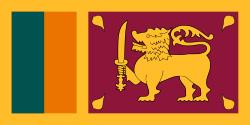| Sri Lanka Army |
|---|
 |
| Components |
| History |
| Equipment |
| Leadership and ranks |
The following tables present the ranks and insignia of the Sri Lanka Army . The ranks are similar to the British army officer ranks and the others.
Contents
- Commissioned officer ranks
- Officer cadet ranks
- Other ranks
- Retired officer's rank
- History
- See also
- Notes
- References
- Bibliography
- External links
At its formation in 1949, the Ceylon Army adopted the rank structures of the British Army.
The highest rank in the Sri Lanka Army is Field Marshal, though the rank has no appointment in the army; it was first awarded in 2015 as an honorary rank to Sarath Fonseka for his wartime service. The rank has been awarded for his whole life. [1]
The highest rank of a serving officer is Lieutenant General (three-star rank), which the Commander of the Army holds. The rank of full general (four-star rank) was given to the Chief of Defence Staff, whose post is now obsolete; it is also awarded to the Commander of the Army on the day of his retirement. Commanders of the Army since the late 1980s have held the rank of lieutenant general, three commanders Sarath Fonseka, [2] Jagath Jayasuriya and Shavendra Silva were promoted to full generals while serving as commander of the army, on the other hand, Shavendra Silva got the duty of the Chief of Defence Staff simultaneously holding the appointment of commander of the army. [3]











